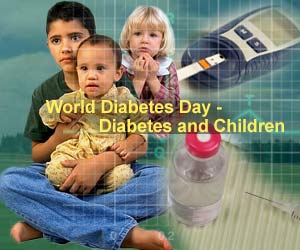Diabetes in children and Young Adults
Initial phase
The first clinical symptoms in children are increased feeling of thirst and increased urination and weight loss. Depending on how quickly the disease is detected, the child can have few complaints. This is late found the child in a coma but can fall. 80 Percent of the children it takes about 3 weeks counting from occurring the first complaints to is detected, that has a diabetes mellitus type 1.
2 to 3 days after the start of the first insulin treatment the child required then less insulin than in the first days, to lower the blood glucose in normal areas. A further reduction of insulin needs adjust after 1 to 3 weeks. The required amount of insulin can be very low. This phase may take only a few weeks, months or even several years. This phase is very important to train the children and parents. This phase does not mean that the disease can heal again.
The child's need for insulin increases sharply after the remission phase. This is the time where it then a complete insulin turns up. The islands produce no insulin itself.
Puberty phase
During puberty, it may be significant fluctuations in the metabolic situation. The need for insulin increases and the fluctuations are for the child or the parents to understand. At this stage, the setting of the patient is usually particularly difficult. The patient often rejects the disease and neglected the necessary treatment.
Adolescent phase
After puberty, there is a reassurance of metabolism. During this time, the need for insulin goes back. At this stage, it is important to note that the amount of insulin is reduced. Otherwise there is a strong weight gain, since the amount of insulin and the daily energy intake permanently above the actual requirement.
Type 2 Diabetes in Children and Young Adults: A “New Epidemic”
As the new president of the American Diabetes Association and as a pediatric endocrinologist, I have had the opportunity to appreciate the recent change in the face of type 2 diabetes in the United States. Type 2 diabetes has changed from a disease of our grandparents and parents to a disease of our children. As more and more children and young adults develop this devastating disease, it has become apparent that we have much to learn about who in the pediatric population is at risk to develop type 2 diabetes, why they develop this disease, how to treat it, and, most importantly, how to prevent this “new epidemic” from destroying future generations of Americans.Type 2 diabetes has been described as a new epidemic in the American pediatric population that has been coincident with the overall 33% increase in diabetes incidence and prevalence seen during the past decade. In 1992, it was rare for most pediatric centers to have patients with type 2 diabetes. By 1994, type 2 diabetes accounted for up to 16% of new cases of pediatric diabetes in urban areas, and by 1999, it accounted for 8–45% of new cases depending on geographic location.
These cases of type 2 diabetes occur mainly in African-American, Mexican-American, Native-American, and Asian-American children and young adults. In Ohio and Arkansas, African-American children with type 2 diabetes represent up to 70–75% of new pediatric diabetes cases. In Ventura, Calif., 31% of new-onset diabetes is seen in Mexican-American youth. The Native-American Pima pediatric population has a type 2 prevalence of at least 20–40/1,000.
As found in the adult population, type 2 diabetes in children and young adults is due to the combination of insulin resistance and relative b-cell failure. While there appears to be a host of potential genetic and environmental risk factors for insulin resistance and limited b-cell reserve, perhaps the most significant risk factor is obesity. Most children who develop type 2 diabetes have a family member with type 2 diabetes; 45–80% have a parent with type 2 diabetes, and 74–90% report at least one affected first- or second-degree relative. Up to 60–90% of youth who develop diabetes have acanthosis nigricans, a thickening and hyperpigmentation of the skin at the neck and flexural areas that is due to insulin resistance. More children and young adults with diabetes have this skin problem than do adults with diabetes. It is so common that it can be used as a marker of youth at risk for type 2 diabetes. Other risk factors include puberty, intrauterine exposure to diabetes, sedentary lifestyle, and female sex.
Despite this increasing incidence and prevalence, little is known about the most effective treatment regimens, the roles of physical activity and nutrition counseling in improving glycemic outcomes, and the most effective ways to reduce cardiovascular risk in these patients. Fewer than 10% of youth with type 2 diabetes are treated with diet and exercise alone. Pharmacological intervention appears to be required for these patients to achieve glycemic targets. In most surveys, practitioners use either insulin or one of the oral agents. For those using oral agents, ∼70% use metformin (Glucophage) and 30% use more than one oral hypoglycemic medication. Once type 2 diabetes is established, the persistence of obesity interferes with the response to treatment and exacerbates the comorbidities of hypertension, dyslipidemia, atherosclerosis, and polycystic ovarian syndrome, which start to appear despite the fact that these patients are still young.
Currently, there are no truly evidence-based specific treatment algorithms for pediatric patients with type 2 diabetes. These need to be rigorously investigated. The National Institutes of Health has recently funded a multi-center consortium to determine the outcomes of different treatment regimens on glycemic control, b-cell preservation, and comorbidities.
There is an opportunity to attempt to prevent type 2 diabetes in youth by addressing the epidemic of childhood obesity. Presently, up to 15–20% of America’s teens 12–18 years of age are overweight. This comes to more than 5 million children.
In addition to weight, activity level is also important. Diabetes occurs in children and teens who are inactive. With the sharp rise in computer games and TV-watching and the trend toward abandoning physical education in schools, fewer children are participating in sports. This increase in sedentary lifestyle has contributed to the type 2 diabetes epidemic.
There is no doubt that the emergence of this epidemic in children and young adults is a major public health problem. Diabetes costs our nation more than $100 billion per year. It devastates lives and robs people of their health and well-being. It is time for our schools and communities to start to play a role in the prevention of diabetes in children.
Schools have to focus on increasing children’s physical activity and improving their nutrition. Schools no longer have physical education curriculums designed to help optimize the health of America’s children. This has to change. Schools must re-institute vigorous physical education programs for all children and in all grades.
Nutrition counseling needs to be available in school so that children understand the importance of healthy eating. The selling of candy and sugar-containing drinks in schools must be forbidden. Fast foods loaded with calories and fat must not be available in school settings. Every food item sold in school must meet a minimum nutritional requirement that will ensure that it is good for children. We must put the health and welfare of our children above the financial benefits accrued by selling junk food in school.
Other community organizations must also help. Our communities need to develop safe locations for children and their families to exercise. After-school care programs need to include physical activities and provide good nutrition. From the fast-food industry to Madison Avenue to Hollywood, the principles of good health—exercise and good nutrition—must be promoted.
We are in the midst of an epidemic. There is a role for each of us in helping to put an end to the rise of this devastating disease in children.









No comments:
Post a Comment